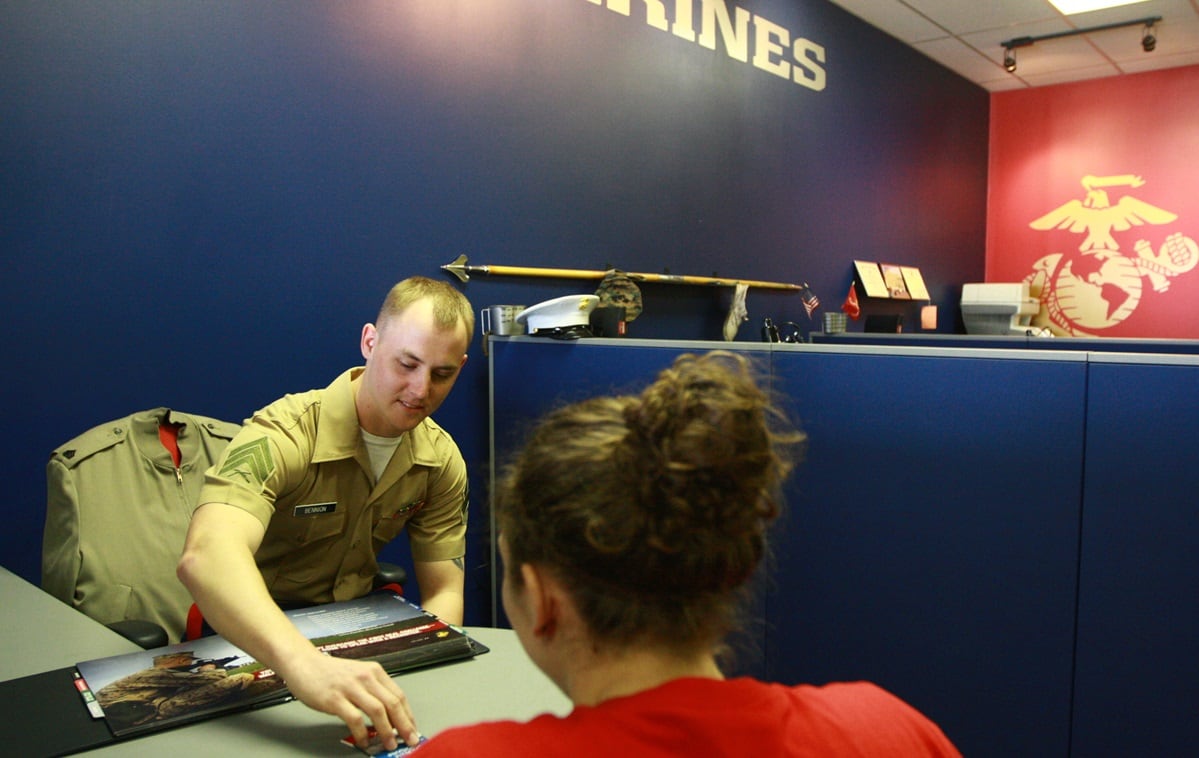As the military services seek to recruit an increasingly disinterested and underinformed population of young Americans, the Marine Corps has quietly begun relocating some of its recruiting hubs, Marine Corps Times has learned.
In an interview in February, Col. Michael Hays, assistant chief of staff for the G-3 directorate of Marine Corps recruiting, called the move a “massive structural realignment” in response to the most challenging recruiting environment the all-volunteer force has ever faced.
“We continue to pull as many levers as we can to ensure the success of Marine Corps recruiting,” Hays said.
Beginning around October 2023, according to Hays, the Marines began the process of closing recruiting headquarters deemed unlikely to perform as desired. To date, officials said, they have closed the Corps’ recruiting station headquarters in Cleveland, Pittsburgh and Des Moines, Iowa.
RELATED

The Marine Corps is now in the process of opening two recruiting centers in trendy urban areas: Austin, Texas, and Orlando, Florida, officials said. A third recruiting center also will open at a location to be determined to complete the changes.
This lever-pull was informed by a “qualified enlisted population,” or QEP, metric developed by the Corps in coordination with CNA, a nonprofit research and analysis organization, recruiting command officials said. This analysis crunches multiple population attributes within geographic areas to predict where recruiters are most likely to succeed.
Qualified enlisted population “helps to inform leadership when determining recruiting boundaries to provide individual recruiters, and thus (Marine Corps recruiting command) an increased likelihood of success,” recruiting command officials told Marine Corps Times in a statement. “We have realized more consistent recruiting success in areas closely aligned to” the qualified enlisted population.
Recruiting Station Cleveland, which fell under the 4th Marine Corps District and oversaw 16,800 square miles’ worth of recruiting offices in northeastern Ohio and the Detroit metro area, held a dissolution ceremony in February ― merging with the Columbus recruiting station to create an Ohio hub, according to published photographs on the Defense Visual Information Distribution Service website.
The Pittsburgh recruiting station, which had at one point been staffed by 60 recruiters, closed its doors May 1.
The Des Moines, Iowa, recruiting station has not publicly announced closure plans, though officials say it has closed. Its website and phone line were down when checked on Monday.
Officer selection stations also are undergoing realignment.
The Corps is in the process of closing stations in Fargo, North Dakota; Reading, Pennsylvania; and Champaign, Illinois, Marine Corps Recruiting Command said.
In turn, new officer selection stations are set to open in the urban regions of Pasadena, California; Tampa, Florida; and San Antonio.
Hays said the CNA-supported data analysis was relatively new, dating back to fiscal year 2022.
While he didn’t go into detail about all the factors the qualified enlisted population analysis pulled in, he said it gave the Marine Corps a good idea of where the most recruits likely to meet baseline standards for service were likely to live.
“Ultimately, what it shows is the population density of those individuals who are qualified for enlistment,” he said.
The southeastern U.S. continues to have the best military recruiting prospects, as has historically been the case, shows CNA data from fiscal year 2019, the most recent year available.
The mid-Atlantic and New England states, including Pennsylvania, and those in the upper Midwest, including Iowa, have the lowest representation of military recruits by population, per the recent data. CNA data shows population trends getting more pronounced over time: Fewer recruits are coming from the Northeast and North Central regions of the U.S., and more from the South, than was the case five years ago.
Officials emphasized that the Marine Corps would continue to have recruiters “responsible for every zip code” in the U.S. during and after the realignment. The recruiting command will continue to evaluate mission attainment and population trends to assess the need for any future changes, they said.
And while offices are closing, officials said the realignment is zero-sum ― meaning the size of the recruiting population will stay the same.
The Marines’ current recruiting station shift, which is set to be complete by October 2025, appears to reveal an emphasis on more urban areas, seeming to echo a strategy the Army has embraced amid its own recruiting struggles.
The population of Des Moines, Iowa, for example, was a bit more than 211,000 people, according to the 2022 census, compared with Austin, at nearly 975,000 people.
And while Cleveland and Orlando, Florida, are comparable by population at more than 300,000 residents each ― Orlando does represent the sixth-largest metropolitan area in the southern U.S. It also has been named the fittest city in Florida, according to a survey released in May.
For its part, the Army announced a strategy shift in 2018, targeting 22 U.S. cities that had previously been overlooked or under-resourced in an effort to overcome a recruiting deficit that has gone on to cause multiple years of target shortfalls.
The Marine Corps has continued to meet recruiting goals while the other services have struggled. But it too has experienced the effects of the COVID-19 pandemic that halted in-person recruiting in schools for years, and the difficulties of finding qualified and interested recruits.
Hays said the Corps’ strategy moving forward would redouble emphasis on presence in high schools and direct engagement with students.
Referencing the widely cited statistic that only about 9% of young Americans are interested in military service, Hays said the Corps saw that as an opportunity, not a hindrance.
Maj. Gen. William Bowers, commander of Marine Corps Recruiting Command, “would kind of flip that on its head,” Hays said. “‘Well, there’s 91% out there that just need to be inspired to serve by our presence and the example that we set.’”
Hope Hodge Seck is an award-winning investigative and enterprise reporter covering the U.S. military and national defense. The former managing editor of Military.com, her work has also appeared in the Washington Post, Politico Magazine, USA Today and Popular Mechanics.




